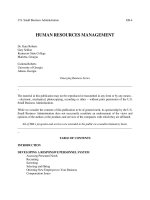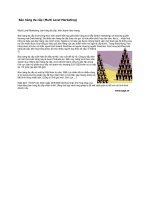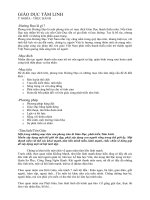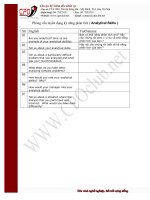Tài liệu E-Human Resource Management 31 pptx
Bạn đang xem bản rút gọn của tài liệu. Xem và tải ngay bản đầy đủ của tài liệu tại đây (691.25 KB, 9 trang )
256 Logan
Copyright © 2005, Idea Group Inc. Copying or distributing in print or electronic forms without written
permission of Idea Group Inc. is prohibited.
• the organizational strategic objective the project supports: the specific
element of the organization’s strategy that is directly served by this
project,
• the purpose of the project (phrased to indicate how the strategic objective
is supported): what the project will be doing to directly support that
objective,
• a list of three to five high-level requirements for the project, and a
reference to where the complete requirements are recorded: the main
activities performed by the product of this project,
• a high-level project schedule with major milestone dates and deliverables:
the key dates in the project, and
• a high-level statement of the project’s budget and funding source: the
broad financial parameters that form part of the definition of project
success.
The project charter should ideally be no more than a page or two, and it should
serve as a touchstone throughout the project. Rather than occupying a binder
on a shelf, the IT project manager and OD practitioner should seek ways to use
the charter as an orienting device throughout the project. Figure 2 provides an
example of a template for the IT Project Charter.
The IT Project Charter establishes clarity about the IT project in a way that
provides the OD practitioner and the IT project team the initial data to begin
the work of improving communication and other processes. The very act of
creating and validating the charter is itself an intervention addressing both clarity
about objectives and an understanding of leadership and stakeholder support.
Once created, the charter is a vital foundation document for the work of
addressing the IT project team’s functioning. If the charter already exists, it is
an invaluable link between the IT Project Success Funnel and the structured
teambuilding approach to improving team effectiveness.
A Teambuilding Approach to IT Project Success
Once the elements of the IT Project Success funnel are established and agreed
upon, the OD practitioner must design ways to use the model as a lever for
positive change with the IT project team. The IT project team is able to improve
Managing and Practicing OD in an IT Environment 257
Copyright © 2005, Idea Group Inc. Copying or distributing in print or electronic forms without written
permission of Idea Group Inc. is prohibited.
performance and minimize the historic issues of poor communication, lack of
leadership support, and unclear objectives through focused teambuilding,
organizational alignment, and organizational learning. Warner Burke notes that
when a workgroup has at least one goal common to all members and when
accomplishment of that goal requires cooperative, interdependent behaviors on
the part of all group members — as for the IT project team — teambuilding may
be an appropriate intervention (Burke, 1982). Teambuilding is an especially
effective intervention for addressing the common issues in IT projects because
its structure provides a framework for addressing organizational alignment and
organizational learning. An IT executive in the U.S. government once remarked
that creating organizational change while continuing to deliver mission-critical
services is like attempting to paint a Boeing 747 in full flight. The structured
framework of teambuilding, organizational alignment, and organizational learn-
ing attempts to do a better job of painting the airplane while keeping the flight
on schedule.
Burke, citing Beckhard, notes that there are four purposes of teambuilding:
1. to set goals or priorities;
2. to analyze or allocate the way work is performed according to team
members’ roles and responsibilities;
3. to examine the way the team is working (its processes such as norms,
decision making, communications, etc.); and
4. to examine relationships among the team members. (Burke, 1982)
Burke elaborates on Beckhard’s purposes by emphasizing that while all these
purposes are operating in a teambuilding effort, one purpose should be defined
as the primary purpose in order to avoid conflicting notions among team
members of the purpose of the effort. In the IT project, the primary purpose of
teambuilding is to address the processes of the team, especially those specific
to the team’s communication behaviors. The reason for this emphasis is that
poor communication among team members is by far the most commonly cited
issue in IT projects, and that better communication may provide clarity about
objectives and leadership support needs.
Burke also notes that Beckhard’s purposes are most effectively used in the
order listed (Burke, 1982). The reason for working from the top of Beckhard’s
model downward is that each level sets context for the levels beneath it. Burke
258 Logan
Copyright © 2005, Idea Group Inc. Copying or distributing in print or electronic forms without written
permission of Idea Group Inc. is prohibited.
notes that it may be a misuse of energy to begin work at the interpersonal
relationship level because these issues may result from misunderstanding in the
other domains. This approach is particularly useful for the IT project team and
its typical issues because it addresses objectives and roles (leadership and
otherwise), two of the most common issues in IT projects, in the process of
working toward the process level, where communication issues can be identi-
fied and resolved.
The work of the IT-focused OD practitioner begins with the first level of
Beckhard’s model, goals and priorities, and continues through roles and
responsibilities toward the focus of the OD effort, the processes of the team
itself, and the interpersonal concerns in its work.
• Goals of the IT-focused OD practitioner: The mission of the OD
practitioner in an IT project — and that of the IT project team — is to
increase the IT project’s contribution to the organization’s strategy. The
OD practitioner’s goal as a part of the IT project team is to increase the
likelihood of project success by facilitating better communication, clearer
objectives, and support for the project throughout the organization. To
achieve these ends, the OD practitioner in an IT project takes into account
alignment of the organization’s strategy, the purpose of the IT project, and
the requirements, schedule, and cost of the project. This orientation aligns
the organizational concerns of the OD practitioner with the project-
specific concerns of the IT professional to define the value boundaries of
work within the project.
The process of completing and validating the project charter is the most
meaningful approach to satisfying the goals and priorities level of the IT
project. With shared understanding of the IT project’s organizational
alignment and project boundaries, the IT project team comes to a clear,
common vision of their work together.
A common issue found at the goals and priorities level is a misalignment
through the project funnel, such as contradictions between project
purpose and organizational strategy, requirements and project purpose,
or any combination of requirements, schedule, and cost. These issues
should become fairly obvious during the OD practitioner’s contracting
phase with the IT project manager, and they should be noted and
addressed or flagged as likely trouble spots.
Managing and Practicing OD in an IT Environment 259
Copyright © 2005, Idea Group Inc. Copying or distributing in print or electronic forms without written
permission of Idea Group Inc. is prohibited.
Since the focus of the teambuilding effort is at the process level, the goals
and priorities level defines the context and objectives for the project
team’s processes. The goals and priorities level, through the model of the
project funnel, also establishes the boundaries for the inputs to both the IT
project team and the OD practitioner’s processes. If the data the OD
practitioner obtains from the organizational or project system (the inputs
to the process level) do not fall within or demonstrably affect the
boundaries of the IT project funnel, they are irrelevant. In short, the OD
practitioner must deliver value in the eyes of her customer, the IT project
team.
• Roles and responsibilities of the IT-focused OD practitioner:
Because of the prominence of the project management approach as a
means to deliver value and increase the probability of success in IT
projects, roles and responsibilities in IT projects tend to be exceptionally
well defined. Project managers usually employ a Responsibility Assign-
ment Matrix (RAM) such as the sample in Table 1 (PMI, 2000), and OD
scholars have advocated similar approaches in teambuilding and organi-
zational structure interventions (Dyer, 1995; Weisbord, 1987; Burke,
1982).
A key concern of the IT-focused OD practitioner is the specific outcomes
to be delivered as a result of having worked with the IT project team.
Specifying desired outcomes and behaviors establishes the parameters of
that relationship. The OD practitioner has a responsibility to select inputs,
interventions, and outputs that fall within the funnel, and thus serve the
Table 1. Responsibility Assignment Matrix (Adapted from Guide to the
Project Management Body of Knowledge, 2000 Edition)
P=Participant; A=Accountable; R=Review Required; I=Input Required; S=Sign-off Required
Phase
Person A Person B Person C Person D Person E Person F
Requirements
S R A P P
Functional
S A P
Design
S R A I P
Development
R S A P
Testing
S P I P
260 Logan
Copyright © 2005, Idea Group Inc. Copying or distributing in print or electronic forms without written
permission of Idea Group Inc. is prohibited.
goals of the project and the strategy of the organization. This responsibility
is demonstrated at the process level in Burke’s model.
• The process of OD in the IT environment: The process level of
Beckhard/Burke’s model is the focus of the teambuilding approach, and
it is where the most critical work with an IT project team is performed. The
most common issue contributing to IT project failure—poor communica-
tion—is a result of dysfunction in the IT project team’s processes. With
the foundation of clear goals and priorities and mutually understood roles
and responsibilities, the OD practitioner can employ the action research
process to diagnose and positively intervene in the IT project team’s
processes, especially those that produce the symptoms of poor commu-
nication.
It is helpful to think of the action research process in the same way an IT
professional thinks of technical processes: a set of steps that receives
inputs and acts upon them to produce outputs. In the case of the IT-
focused OD effort, the inputs to the process are selected from within the
IT Project Success Funnel, and the quality of the outputs to be produced
are defined within the parameters of this same funnel (Figure 3). The funnel
serves as an orienting device used to narrow the range of possible inputs
and focus the desired results of the OD practitioner’s work.
In practice, this model provides a foundation for each step of the action
research process. In entry and contracting, the OD practitioner and IT
project manager already have a mutual understanding of the environment
in which the IT project operates, and of its goals and staff responsibilities.
The OD practitioner collects data that fall within the boundaries of the IT
Project Success Funnel and provides group feedback within these same
parameters. The IT project team and OD practitioner can jointly decide
Figure 3. Combining the IT Project Success Funnel with the Action
Research Process to define input and output quality
Organizational strategy
Project purpose
Requirements
Schedule
Cost
Organization al strategy
Project purpose
Requirements
Schedule
Cost
Action
Research
Process
input
output









